Problem Set 2
- 7.
-
For each of the following expressions independently,
determine as many integer values of x as you can that it is
a perfect square. Indicate whether your list is complete or not.
-
-
(a) 1 + x;
-
-
(b) 1 + x + x2;
-
-
(c) 1 + x + x2 + x3;
-
-
(d) 1 + x + x2 + x3 + x4;
-
-
(e) 1 + x + x2 + x3 + x4 + x5.
View solution
- 8.
-
Let ABC be an arbitrary triangle with the points D, E, F
on the sides BC, CA, AB respectively, so that
and
Prove that [DEF] £ 1/4[ABC], with equality if and only
if two at least of the three points D, E, F are midpoints of the
corresponding sides.
(Note: [XYZ] denotes the area of triangle XYZ. This is
Problem 2240 in CM+M2, May, 1997.)
View solution
- 9.
-
ABCD is a square with incircle G. Let l be a
tangent to G, and A¢, B¢, C¢, D¢ be points on l
such that AA¢, BB¢, CC¢, DD¢ are all perpendicular to l.
Prove that AA¢·CC¢ = BB¢·DD¢.
-
-
(Note: XY here and in the previous problem denotes the length
of the segment XY; the dot is ordinary multiplication. This is
Problem 2237 in CM+MM, April, 1997.)
View solution
- 10.
-
(a) Three ants crawl along the sides of a fixed triangle in
such a way that the centroid (intersection of the medians) of the
triangle they form at any moment remains constant. Show that this
centroid coincides with the centroid of the fixed triangle if one of
the ants travels along the entire perimeter of the triangle.
-
-
(b) Is it indeed always possible for a given fixed triangle
with one ant at any point on the perimeter of the triangle
to place the remaining two ants somewhere on the perimeter so that
the centroid of their triangle coincides with the centroid of the fixed
triangle?
View solution
- 11.
-
The faces of a tetrahedron are formed by congruent triangles.
If a is the angle between a pair of opposite edges of the
tetrahedron, show that
where B and C are the angles adjacent to one of these edges in a
face of the tetrahedron.
View solution
- 12.
-
(a) Give an example of a pair a, b of
positive integers, not both prime,
for which 2a - 1, 2b - 1 and a + b are all
primes. Determine all possibilities for which a and b are
themselves prime.
-
-
(b) Suppose a and b are positive integers such that
2a - 1, 2b - 1 and a + b are all primes. Prove that
neither ab + ba nor aa + bb are multiples of a + b.
View solution
Solutions to Problem Set 2
7.
- 7.
-
(a) 1 + x is a square when x = u2 - 1 for some integer
u (or when x is the product of two integers u-1 and u+1 that
differ by 2).
- 7.
-
(b) First solution. Suppose that x2 + x + 1 = u2.
Then (2x + 1)2 + 3 = 4x2 + 4x + 4 = 4u2 = (2u)2, whence
|
3 = (2u)2 - (2x + 1)2 = (2u + 2x + 1)(2u - 2x - 1) . |
|
The factors on the right must be ±3 and ±1 in some order,
and this leads to the possibilities (x, u) = (-1, ±1),(0, ±1).
-
-
(b) Second solution. If x > 0, then
x2 < x2 + x + 1 < (x + 1)2, so that x2 + x + 1 cannot be
square. If x < -1, then x2 > x2 + x + 1 > (x + 1)2 and
x2 + x + 1 cannot be square. This leaves only the possibilities
x = 0, -1.
-
-
(b) Third solution. For given u, consider the
quadratic equation
Its discriminant is 1 - 4(1 - u2) = 4u2 - 3. It will have
integer solutions only if 4u2 - 3 = v2 for some integer v,
i.e., (v + 2u)(v - 2u) = -3. The only possibilities are
(u, v) = (±1, ±1), (±1, -±1).
-
-
(b) Fourth solution. [J. Chui] If f(x) = 1 +x + x2, then f(x) = f(-(x+1)), so we need deal only with
nonnegative values of x. We have that f(0) = f(-1) = 1 is
square. Let x ³ 1 and suppose that 1 + x + x2 = u2 for
some integer u. Then (1 + x)2 - u2 = x > 0 so that
1 + x > u. This implies that x ³ u, whence
x2 ³ u2 = x2 + x + 1, a contradiction. Thus the only
possibilities are x = 0, -1.
-
-
(b) Fifth solution. [A. Birka] Suppose that
x2 + x + 1 = u2 with u ³ 0. This is equivalent to
x = (1 + x)2 - u2 = (1 + x + u)(1 + x - u), so that
1 + x + u and 1 + x - u both divide x. If x ³ 1,
then 1 + x + u exceeds x and so cannot divide x.
If x £ 0, then (-x) + u - 1 divides x, which is
impossible unless u = 1 or u = 0. Only u = 1 is viable, and
this leads to x = 0, -1.
- 7.
-
(c) First solution. 1 + x + x2 + x3 = (1 + x2)(1 + x). Let d be a common prime divisor of 1 + x
and 1 + x2. Then d must also divide x(x - 1) = (1 + x2) - (1 + x). Since gcd(x, x + 1) = 1, d must divide
x - 1 and so divide 2 = (x + 1) - (x - 1). Hence, the only
common prime divisor of 1 + x2 and 1 + x is 2.
-
-
Suppose 1 + x + x2 + x3 = (1 + x2)(1 + x) is square.
Then there are only two possibilities:
|
(i) 1 + x2 = u2 and 1 + x = v2 for integers u and v ; |
|
|
(ii) 1 + x2 = 2r2 and 1 + x = 2s2 for integers r and s . |
|
-
-
Ad (i): 1 = u2 - x2 = (u - x)(u + x) Û(x, u) = (0, ±1).
-
-
Ad (ii): We have x2 - 2r2 = -1 which has
solutions
|
(x, r) = (-1, 1), (1, 1), (7, 5), (41, 29), ¼ . |
|
The complete set of solutions of x2 - 2r2 = ±1 in positive
integers is given by { (xn, rn) : n = 1, 2, ¼}, where
xn + rn Ö2 = (1 + Ö2)n, with odd values of
n yielding solutions of x2 - 2r2 = -1. We need to select
values of x for which x + 1 = 2s2 for some s. x = -1, 1, 7
work, yielding
|
1 - 1 + (-1)2 + (-1)3 = 0 |
|
|
1 + 7 + 72 + 73 = 8 ×50 = 202 . |
|
There may be other solutions.
- 7.
-
(d) First solution. Let f(x) = x4 + x3 + x2 + x +1 = (x5 - 1)/(x - 1), with the quotient form for x ¹ 1.
We have that f(0) = f(-1) = 12 and f(3) = (243 - 1)/2 = 112.
Also f(1) = 5 and f(2) = 31. Suppose that x ³ 4. Then
x(x - 2) > 3, so that x2 > 2x + 3. Hence
|
| |
|
|
= 4x4 + 4x3 + 5x2 + 2x + 1 |
| |
| > 4x4 + 4x3 + 4x2 + 4x + 4 = 4f(x) |
|
| |
|
and
|
| |
|
|
= (4x4 + 4x3 + x2) + (3x2 + 4x + 4) |
| |
| = (2x2 + x)2 + (3x2 + 4x + 4) > (2x2 + x)2 . |
|
| |
|
Thus, 4f(x) lies between the consecutive squares (2x2 + x)2
and (2x2 + x + 1)2 and so cannot be square. Hence f(x) cannot
be square.
-
-
Similarly, if x £ -2, then x(x - 2) > 3 and
3x2 + 4x + 4 > 0, and we again find that 4f(x) lies between
the consecutive squares (2x2 + x)2 and (2x2 + x + 1)2.
Hence f(x) is square if and only if x = -1, 0, 3.
-
-
(d) Second solution. [M. Boase] For x > 3,
|
(x2 + |
x
2
|
)2 < x4 + x3 + x2 + x + 1 < (x2 + |
x+1
2
|
)2 |
|
so that, lying between two half integers, x4 + x3 + x2 + x + 1 is
not square. Suppose x = -y is less than -1.
Since y - 1 < 3/4y2 and y2 + 2y - 3 = (y + 3)(y - 1) > 0,
|
(y2 - |
y
2
|
)2 < 1 - y + y2 - y3 + y4 < (y2 - |
y-1
2
|
)2 |
|
so again the middle term is not square. The cases
x = -1, 0, 1, 2, 3 can
be checked directly.
- 7.
-
(e) First solution. Let
|
| |
|
|
= x5 + x4 + x3 + x2 + x + 1 = (x + 1)(x4 + x2 + 1) |
| |
| = (x + 1)[(x2 + 1)2 - x2] = (x + 1)(x2 + x + 1)(x2 - x + 1) . |
|
| |
|
Observe that g(x) < 0 for x £ 2, so g(x) cannot be square
in this case. Let us analyze common divisors of the three
factors of g(x).
-
-
Suppose that p is a prime divisor of x + 1.
Then
|
x2 + x + 1 = x(x + 1) + 1 º 1 mod p |
|
and
|
x2 - x + 1 = x(x + 1) - 2(x + 1) + 3 º 3 mod p . |
|
Hence gcd(x + 1, x2 + x + 1) = 1 and gcd(x + 1, x2 - x + 1) is
either 1 or 3.
-
-
Suppose q is prime and x2 + x + 1 º 0 (mod q).
Then x(x + 1) º -1 (mod q), and x2 - x + 1 º -2x
(mod q). Since x2 + x + 1 is odd, q ¹ 2, then
x2 - x + 1 \not º 0 (mod q). Hence gcd(x2 + x + 1,x2 - x + 1) = 1.
-
-
As we have seen from (b), x2 + x + 1 is square if and only
if x = -1 or 0. Indeed g(-1) = 02 and g(0) = 12. Otherwise,
x2 + x + 1 cannot be square. But gcd(x2 + x + 1, (x + 1)(x2 - x + 1)) = 1, so g(x) cannot be a square either.
Hence x5 + x4 + x3 + x2 + x + 1 is square if and only if
x = -1 or 0.
-
-
(e) Second solution. [M. Boase] Observe that
x5 + x4 + ¼+ 1 = (x3 + 1)(x2 + x + 1). Since
x3 + 1 = (x2 + x + 1)(x - 1) + 2, the greatest common divisor
of x3 + 1 and x2 + x + 1 must divide 2. But x2 + x + 1 = x(x + 1) + 1 is always odd, so the greatest common divisor must
be 1. Hence x2 + x + 1 and x + 1 must both be square. Hence
x must be either -1 or 0.
8.
- 8.
-
First solution. Let BF = mBA, BD = lBC and CE = nCA.
-
-
The conditions are that
|
l £ m £ |
1
2
|
and 1 - n £ 1 - m or m £ n . |
|
We observe that [BDF] = lm[ABC].
-
-
To see this, let BG = lBA. Then
|
[BDF] = |
m
l
|
[BGD] = |
m
l
|
l2 [ABC] = ml[ABC] . |
|
Similarly [AFE] = (1 - m)(1 - l)[ABC] and
[DEC] = n(1 - l)[ABC].
-
-
Hence
|
| |
|
|
= (1 - lm-(1 - m)(1 - n) - n(1 - l))[ABC] |
| |
| |
| = |
æ
ç
è
|
|
1
4
|
- ( |
1
2
|
- m)2 -(m- l)(n- m) |
ö
÷
ø
|
[ABC] £ |
1
4
|
[ABC] |
|
| |
|
with equality if and only if m = 1/2 and either
l = m = 1/2 or n = m = 1/2. The result follows.

- 8.
-
Second solution. Let G be on AC so that
FG || BC. Then, since [AE/EC] £ [AF/FB],
E lies in the segment AG.
-
-
Since [BD/DC] £ [BF/FA], DF produced
is either parallel to AC or meets CA produced at a point X beyond
A. Hence the distance from G to FD is not less than the distance
from E to FD, so that [DEF] £ [FGD]. The area of [FGD] does
not change as D varies along BC. To maximize [DEF] is suffices
to consider the special case of triangles [FGD]. Let
AF = xAB. Then FG = xBC and the heights of DDFG and
DABC are in the ratio 1 - x. Hence
which is maximized when x = 1/2. The result follows from
this, with [DEF] being exactly one quarter of [ABC] when
F and G are the midpoints of AB and AC respectively.
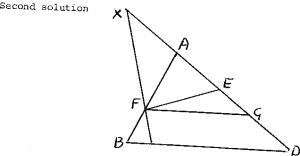
- 8.
-
Third solution. Set up the situation as in the
second solution. Let BF = tFA. Then AB = (1 + t)FA, and the
height of the triangle FGD is t/(1+t) times the height of
the triangle ABC. Hence
|
[DEF] £ [FGD] = |
t
(1+t)2
|
[ABC] . |
|
Now
|
|
1
4
|
- |
t
(1 + t)2
|
= |
(1 - t)2
4(1 + t)2
|
³ 0 |
|
so that t(1 + t)-2 £ 1/4 and the result follows. Equality
occurs if and only if t = 1 and E = G, i.e., F and E are
both midpoints of their sides.
9.
- 9.
-
First solution. Let G be the circle
of equation x2 + y2 = 1 and let l be the line of equation
y = -1. The points of the square must lie on the circle of
equation x2 + y2 = 2. Let them be
for some angle q with -p/4 £ q £ p/4.
Observe that 1/Ö2 £ cosq £ 1 and that
-1/Ö2 £ sinq £ 1/Ö2.
-
-
Then A¢ ~ (Ö2 cosq, -1), B¢ ~ (-Ö2 sinq, -1), C¢ ~ (-Ö2 cosq, -1) and D¢ ~ (Ö2 sinq, -1), so that
AA¢ = 1 + Ö2sinq, BB¢ = 1 + Ö2cosq,
CC¢ = 1 - Ö2sinq and DD¢ = 1 - Ö2cosq.
Hence
|
| |
|
|
= (1 + Ö2 sinq)(1 - Ö2 sinq) -(1 + Ö2 cosq) |1 - Ö2 cosq| |
| |
|
= (1 + Ö2 sinq)(1 - Ö2 sinq) +(1 + Ö2 cosq)(1 - Ö2 cosq) |
| |
| = 1 - 2sin2 q+ 1 - 2cos2 q = 0 . |
|
| |
|
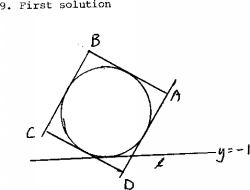
- 9.
-
Second solution. One can proceed as in the first
solution, taking the four points on the larger circle at the intersection
with the perpendicular lines y = mx and y = -x/m. The
points are
|
A ~ |
æ
ç
è
|
|
Ö2
|
, |
mÖ2
|
|
ö
÷
ø
|
B ~ |
æ
ç
è
|
|
-mÖ2
|
, |
Ö2
|
|
ö
÷
ø
|
|
|
|
C ~ |
æ
ç
è
|
|
Ö2
|
, |
-mÖ2
|
|
ö
÷
ø
|
D ~ |
æ
ç
è
|
|
mÖ2
|
, |
-Ö2
|
|
ö
÷
ø
|
. |
|
In this case, the products turn out to be equal to
|(m2 - 1)/(m2 + 1) |.
- 9.
-
Third solution. [A. Birka] Let the circle have
equation x2 + y2 = 1 and the square have vertices
A ~ (1, 1), B ~ (-1, 1), C ~ (-1, -1), D ~ (1, -1).
Suppose, wolog, that the line l is tangent
to the circle at P (t, Ö[(1 - t2)]) with 0 < t < 1 and
intersects CB produced in Y and AD in X. The line l
has equation tx + Ö[(1 - t2)] y = 1 and so the coordinates
of X are (1, u) and of Y are (-1, 1/u) where
u = (1 - t)/Ö[(1 - t2)]. Now
YB:YC = (1 - u):(1 + u) = AX:XD.
Since DYBB¢ is similar to DYCC¢,
BB¢:CC¢ = AA¢:DD¢, and the result follows.
- 9.
-
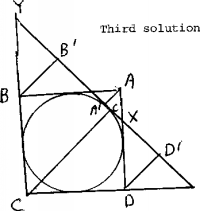
Comment. If the circle has equation
x2 + y2 = r2, the square has vertices (±r, ±r)
and the line has equation through a point (a, b) on
the circle has equation ax + by = r2, then the distance product
is 2ab.
10.
- 10.
-
(a) First solution. Recall that the centroid
lies two-thirds of the way along the median from a vertex
of the triangle to its opposite side. Let ABC be the fixed
triangle and let PQ || BC, RS || AC and TU || BA, as in the
diagram, with PQ, RS and TU intersecting in the centroid G.
-
-
Observe, for example, that if X and Y lie on PQ and BC
respectively, then AX:XY = 2:3. It follows from this that, if one
ant is at A, then the centroid of the triangle formed by the
three ants lies inside DAPQ (otherwise the midpoint of the
side opposite the ant at A would not be in DABC).
Similarly, if one ant is at B (respectively C) then the centroid
of the ants' triangle lies within DBRS (respectively
DCTU). Thus, if one ant traverses the entire perimeter,
the centroid of the ants' triangle must lie inside the intersection
of these three triangles, the singleton { G }. The result
follows.
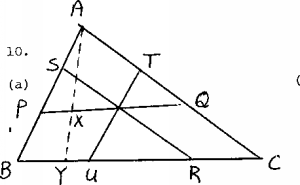
- 10.
-
(b) First solution. Suppose the vertices of the
triangle are given by the planar vectors a, b and
c; the centroid of the triangle is at 1/3(a + b + c). Suppose that one ant is placed
at ta + (1 - t)b for 0 £ t £ 1. Place
the other two ants at tb + (1 - t)c and tc+ (1 - t)a. The centroid of the ants' triangle is at
|
|
1
3
|
[(ta + (1 - t)b) +(tb + (1 - t)c) + (tc + (1 - t)a) = |
1
3
|
(a + b + c) . |
|
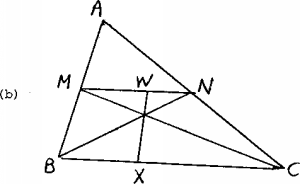
-
-
(b) Second solution. If one ant is at a vertex, then we
can replace the remaining ants at the other vertices of the fixed
triangle. Suppose, wolog, the ant is at X in the side BC.
-
-
Let MN be the line joining the midpoints M and N of
AB and AC respectively; MN || BC. Let XG meet
MN at W. Since BG:BN ( = CG:CM) = 2:3,
it follows, by considering the similar triangles BGX and NGW,
that XG:XW = 2:3. Hence the midpoint of the segment joining
the other two ants' positions must be at W. Thus, the problem now
is to find points Y and Z on the perimeter of DABC
such that W is the midpoint of YZ. We use a continuity
argument.
-
-
Let UV be any segment containing W whose endpoints lie on
the perimeter of DABC. Let Y travel counterclockwise around
the perimeter from U to V, and let Z be a point on the perimeter
such that W lies on YZ. When Y is at U, YW:WZ = VW:WV,
while when Y is at V, YW:WZ = VW:WU. Hence YW:WZ varies
continuously from a certain ratio to its reciprocal, so there must
be a position for which YW = WZ.
-
-
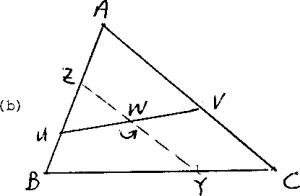
(b) Third solution. [A. Panayotov] Suppose that the
triangle has vertices at (0, 0), (1, 0) and (u, v), so that
its centroid is at (1/3(1 + u), v/3). Wolog,
let one ant be at (a, 0) where 0 £ a £ 1. Put the second
ant at (u, v). Then we will place the third ant at a point
(b, 0) on the x-axis. We require that 1/3(a + b + u) = 1/3(1 + u), so that b = 1 - a. Clearly, 0 £ b £ 1
and the result follows.
11.
- 11.
-
First solution. We first establish that we must
have AD = BC, AB = CD and AC = BD. This is obvious if
the triangular faces are equilateral. Suppose that DABC
is isosceles with AB = AC ¹ BC. If AB = AD, when BC = BD
and DBCD would fail to be congruent to DABC.
Hence AB = AC = BD = CD. Suppose DABC is scalene.
Since DABC º DABD, AD must be equal to one
of AB, AC or BC. Since DABD and DACD are
not isosceles, the first two possibilities are excluded and
so AD = BC. The other cases follow similarly.
Fold out the tetrahedron flat to the configuation of the diagram.
-
-
Wolog, we can assign coordinates
|
A ~ (a, b, 0) B ~ (-1, 0, 0) C ~ (1, 0, 0) |
|
|
D1 ~ (-a, -b, 0) D2 ~ (a + 2, b, 0) (a - 2, b, 0) |
|
with a, b positive. Since the Di swing up to D
about the hinges BC, CA, AB, D must lie vertically
above a point E in the (x, y)-plane for which
D1 E ^BC, D2 E ^AC, D3E ^AB. This point
E is given by
|
E ~ |
æ
ç
è
|
-a , |
2a2 + b2 - 2
b
|
, 0 |
ö
÷
ø
|
|
|
so that, for some value of t,
|
D ~ |
æ
ç
è
|
-a , |
2a2 + b2 - 2
b
|
, t |
ö
÷
ø
|
. |
|
Using the fact that |AD | = 2 and |CD | = |CD1 |, we find that
|
bt2 = 4(1 - a2)(b2 + a2 - 1) = 4(b2 + 2a2 - 1 - a2b2 - a4) . |
|
We check that the quantity on the right is indeed positive. Note that
each angle of DABC is acute. For if ÐA ³ 90°,
then ÐD3 AB + ÐD2 AC £ 90° and D3A and
D2A could not fold up to coincide in a point above the plane.
Since ÐB < 90° and ÐC < 90°,
A lies outside the circle diameter BC. Hence a2 < 1 and
a2 + b2 > 1.
-
-
Now BC = 2(1, 0, 0),
|
AD = 2 |
æ
ç
è
|
-a, |
a2 - 1
b
|
, |
|
| _____________
Ö(1-a2)(b2+a2-1)
|
b
|
|
ö
÷
ø
|
, |
|
and |AD | = |BC | = 2.
Hence
|
cosa = |
BC·AD
|BC ||AD |
|
= -a . |
|
Also sin(B+C) = sinA, so, by the Law of Sines,
|
| |
|
|
= |
æ
ç
è
|
|
sinB
sinA
|
|
ö
÷
ø
|
cosC- |
æ
ç
è
|
|
sinC
sinA
|
|
ö
÷
ø
|
cosB |
| |
|
= |
|AC |
2
|
cosC - |
|AB |
2
|
cosB |
| |
| = |
(1 - a) - (a + 1)
2
|
= -a = cosa . |
|
| |
|
[Note that |AC |cosC is the length of the
projection of AC onto AB, namely 1 - a.]
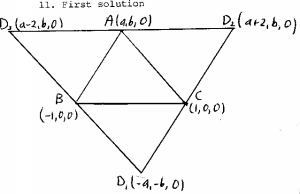
- 11.
-
Second solution. [A. Chan]
Let PQRS be the tetrahedron. PQ = RS,
PS = QR, PR = QS. Let B = ÐPQS = ÐPRS = ÐQPR = ÐQSR and C = ÐSPQ = ÐSRQ = ÐPQR = ÐPSR. Then
|
| |
|
| |
| |
| = |PQ ||PS |cosC - |PQ ||PR |cosB . |
|
| |
|
Therefore
|
|SR |cosa = |PS |cosC - |PR |cosB . |
|
By the Law of Sines,
|
|
|PR |
sinC
|
= |
|PS |
sinB
|
= |
|SR |
sin(B+C)
|
, |
|
whence
|
|SR |cosa = |
|SR |sinB cosC
sin(B+C)
|
- |
|SR |cosB sinC
sin(B+C)
|
= |SR | |
sin(B-C)
sin(B+C)
|
. |
|
The result follows.
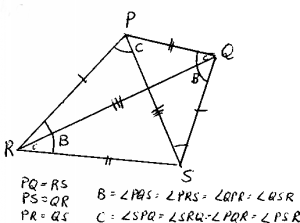
- 11.
-
Third solution. [I. Panayotov] Assign
coordinates A ~ (u, v, 0), B ~ (0, 0, 0),
C ~ (p, q, r) and D ~ (w, 0, 0). Let
|AD | = |BC | = a, |BD | = |AC | = b and |AB | = |CD | = c.
Suppose that a is the angle between AD and BC.
|
a2 cosa = (u - w, v, 0)·(p, q, r) = pu - pw + qv . |
|
Let B = ÐABC and C = ÐCBD = ÐBCA. Then
|
ac cosB = (u, v, 0)·(p, q, r) = pu + qv |
|
and
|
ab cosC = (w, 0, 0)·(p, q, r) = pw . |
|
Then
|
a2 cosa- ac cosB + ab cosC = 0 |
|
whence
|
| |
|
| |
|
= |
a sinC cosB - a sinB cosC
sinA
|
|
| |
|
| |
|
12.
- 12.
-
(a) First solution. (a, b) = (3, 2) yields
2a - 1 = 5, 2b - 1 = 3 and a + b = 5; (a, b) = (3, 4)
yields 2a - 1 = 5, 2b - 1 = 7 and a + b = 7. Suppose that
a and b are primes. Then for a + b to be prime, a + b
must be odd, so that one of a and b, say b, is equal to 2.
Thus, we require the a + 2 and 2a - 1, along with a, to be
prime. This is true when a = 3.
-
-
Now suppose a is an odd prime exceeding 3. Then
a º ±1 (mod 6), so the only way a and a + 2 can
both be prime is for a º -1 (mod 6), whence 2a - 1 º -3 (mod 6). Thus, 3 divides 2a - 1, and since
2a - 1 ³ 9, 2a - 1 must be composite.
- 12.
-
(b) First solution. We first recall a bit of theory.
Let p be a prime. By Fermat's Little Theorem, ap-1 º 1
(mod p) whenever gcd(a, p) = 1. Let d be the smallest positive
integer for which ad º ±1 (mod p). Then d divides
p-1, and indeed divides any positive integer k for which
ak º ±1 (mod p). Now to the problem.
-
-
Since a + b is prime, a ¹ b. Wolog, let a > b
and let p = a + b. Then a º -b (mod p), so that
|
ab + ba º (-b)b + ba º bb((-1)b + ba-b) . |
|
Suppose, if possible, that p divides ab + ba. Then, since
b < p, gcd(b, p) = 1 and so ba-b º (-1)b+1 (mod p).
It follows that
|
b2b-1 = b(p-1)-(a-b) º (-1)b+1 mod p . |
|
Now 2b - 1 is prime, so that 2b - 1 must be the smallest
exponent d for which bd º ±1 (mod p). Hence
2b - 1 divides a - b, so that for some positive integer c,
a - b = c(2b - 1), whence
a = b + 2bc - c and so
|
2a - 1 = 2b - 1 + (2b - 1)2c = (2b - 1)(2c + 1) . |
|
But 2a - 1 is prime and 2b - 1 > 1, so 2c + 1 = 1 and c = 0.
This is a contradiction. Hence p does not divide ab + ba.
-
-
Similarly, using the fact that ab + ba º (-b)a + bb º bb ((-1)a ba-b + 1), we can show that
p does not divide aa + bb.
-
-
(b) Second solution. [M. Boase] Suppose that a and
b exist as specified. Exactly one of a and b is
odd, since a + b is prime. Let it be a. Modulo a + b, we have
that
|
0 º ab + ba = ab + (-a)a º ab - aa º aa(ab-a - 1) or ab(1 - aa-b) |
|
according as a < b or a > b. Hence a|b-a | - 1 º 0 (mod a + b). Now a + b - 1 ±|b - a | = 2a - 1 or 2b - 1, and aa + b - 1 º 1 (mod a + b)
(by Fermat's Little Theorem). Hence a2a - 1 º a2b - 1 º 1 (mod a + b). Both 2a - 1 and 2b - 1 exceed 1 and are
divisible by the smallest value of m for which am º 1
(mod a + b). Since both are prime, 2a - 1 = 2b - 1 = m, whence
a = b, a contradiction. A similar argument can be applied to
aa + bb.
-
-
(c) Third solution. Suppose, if possible, that one of
ab + ba and aa + bb is divisible by a + b. Then a + b
divides their product aa+b + (ab)a + (ab)b + ba+b.
By Fermat's Little Theorem, aa+b + ba+b º a + b º 0 (mod a+b), so that (ab)a + (ab)b º 0 (mod a + b).
Since a + b is prime, it is odd and so a ¹ b. Wolog, let
a > b. Then
|
(ab)a + (ab)b = (ab)b[(ab)a-b + 1] |
|
and gcd(a, a+b) = gcd(b, a+b) = 1, so that
(ab)a-b + 1 º 0 (mod a + b). Since (ab)a+b-1 º 1 (mod a + b), it follows that (ab)2a-1 º (ab)2b-1 º -1 (mod a+b). As in the foregoing solution, it follows that
a = b, and we get a contradiction.










